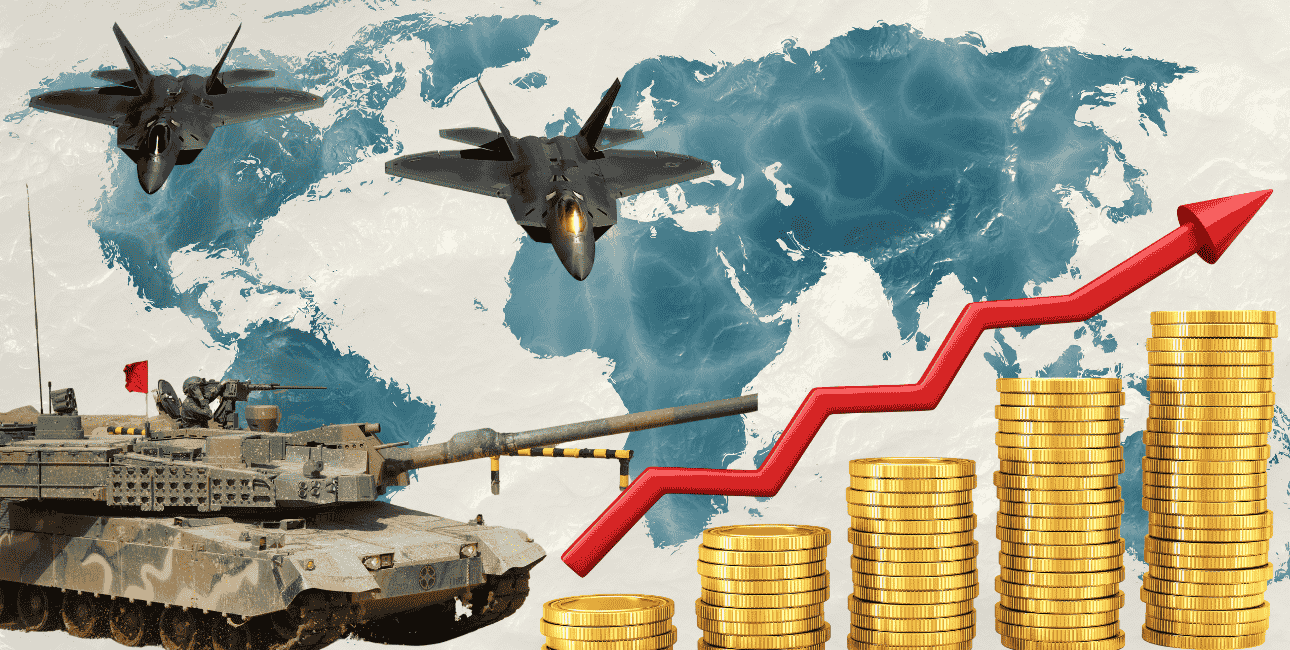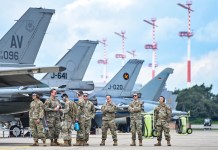Defense stocks worldwide are witnessing an unprecedented bull run. From Europe to Asia, Defense stocks are soaring to new heights. However, South Korea’s Hanwha Aerospace Co. has emerged as the world’s best-performing defense stock.
Hanwha Aerospace shares have risen by more than 3,100% in the last five years, by more than 175% in the last year, and by more than 7% in the last month, making it the best-performing defense stock on Bloomberg’s WORLD index.
Along with its smaller rival, Hyundai Rotem, these two defense stocks have been the top two gainers in Asia’s stock market so far this year, more than doubling in value.
On December 30, 2024, Hanwha Aerospace’s share stood at 326,500 KRW (South Korean won). On March 18, the stock touched 764,000 KRW, more than doubling in value in less than three months.
Similarly, Hyundai Rotem stock stood at 49,700 KRW on December 30, 2024. On March 21, 2025, it touched the high of 1,15,700 KRW, again, more than doubling in value in less than three months.
Similarly, German defense manufacturer Rheinmetall is also witnessing a bull rally. The stock stood at 614 euros on December 30, 2024. On March 18, the stock touched a high of 1445 euros. Again, more than doubling in value this year.
What’s Causing The Defense Stocks Boom
A host of factors are causing the unprecedented worldwide rally in defense stocks: the three-year-long war between Russia and Ukraine, the US$ 832 billion European rearmament program, rising geopolitical tensions in the Middle East, and the Israeli war on Hamas, Hezbollah, and the Houthis.
The Syrian conflict and the involvement of regional powers like Iran, Turkey, and Russia in it, the tensions between Azerbaijan and Armenia, which can turn into a conflict at any time, the rising tensions on the Korean peninsula, and the US-China rivalry in the Asia-Pacific.

Additionally, China’s assertive behavior in the South China Sea is pushing countries in the Asia-Pacific, like the Philippines, Australia, and Taiwan, to boost defense spending. All these factors are contributing to these countries’ increased defense spending and fueling a bull run in defense stocks.
US Defense Stocks Missing The Bull Rally
However, despite this worldwide rally in defense stocks, US defense stocks are not benefiting as much as European and Asian defense stocks.
This is despite the fact that the US remains the world’s largest defense equipment exporter. According to a recent SIPRI report, the United States is also the world’s largest exporter of major arms, accounting for 43% of global arms exports between 2020 and 2024.
Now, compare this to the performance of the US defense stocks this year. Lockheed Martin, one of the US’s biggest defense manufacturers and the developer of stealth fighter jets like the F-22 Raptor and F-35 Lightning II, has seen its stock decline in value this year.
It stood at USD 483 on December 30, 2024, and USD 435 on March 24, 2025, witnessing a nearly 10 % fall in its value this year.
Similarly, Boeing, another major US defense manufacturer that recently won the award for designing and developing the F-47, the next-generation US Fighter jet, has had its stock mostly stagnate in value this year. It stood at USD 176.5 on December 30, 2024, and USD 181 on March 24, even though it had won a multi-billion dollar contract for the F-47.
What explains the disappointing performance of US defense stocks despite a worldwide rally of defense stocks?
Surprisingly, U.S. President Donald Trump’s many statements about European security, his supposedly soft approach towards Russia, the decision to temporarily halt US defense aid to Ukraine, and his threats to annex Canada and Greenland might have contributed to the weaker-than-expected performance of the US defense stocks.
These threats have made the US’s European allies look for alternative sources of defense equipment to reduce their dependence on the US.
Countries like Canada and Portugal are rethinking their orders for F-35 fighter jets. France is positioning its Rafale as an alternative to US fighter jets. Many European countries are looking at defense firms like Hanwha Aerospace to buy weapons that are also cheaper than the US weapons.
Hanwha Aerospace is supplying Poland with 368 K9 self-propelled howitzers (including K9A1 and K9PL variants) under two contracts, with deliveries expected to continue through 2027.
Meanwhile, the Australian Army has officially taken delivery of its first batch of South Korean Huntsman vehicles, with local production of the advanced artillery system currently underway.
Hanwha Defense Australia (HDA), a subsidiary of South Korea’s Hanwha Aerospace, supplied two AS9 155mm/52 caliber tracked self-propelled howitzers (SPHs) and one AS10 armored ammunition resupply vehicle (AARV) to the Australian Army in March this year.
Hanwha will manufacture 28 AS9 SPHs and 14 AS10 AARVs over the next three years as part of an AUD1 billion (USD 622 million) contract signed in 2021.
Expectations for overseas growth have helped the Hanwha group’s market capitalization nearly double since the start of the year to around 73 trillion Korean won (US$50 billion).
“We are witnessing signs of a new Cold War as every country is seeking to strengthen its own security,” Choi Kwangwook, chief investment officer at TheJ Asset Management with 3.8 trillion won in assets under management, was quoted as saying by Fortune. “Demand for weapons is exploding now.”
Earlier this month, Hanwha unveiled plans for the aerospace business to raise 3.6 trillion won (US$2.5 billion) to increase overseas and domestic production and meet growing international demand.
Asian Lockheed Martin In The Making
In recent years, the South Korea-based company has gained considerable recognition for its success in international arms markets, with many even labeling it as a “Korean-version Lockheed Martin.”
Originally established as a gunpowder manufacturer, Hanwha Corporation has since evolved into a comprehensive defense firm and one of South Korea’s largest industrial conglomerates.
Founded in 1952 during the Korean War, the company laid the foundation for what is now the Hanwha Group, a dominant force in both domestic and international defense industries.
With manufacturing facilities in South Korea, the United States, Germany, Australia, and Vietnam, Hanwha has established itself as a truly global defense manufacturer. In addition to its production sites, the company maintains marketing and sales operations in nations like Canada and Japan.
Hanwha’s ascent as a global defense leader can be attributed to its cutting-edge military equipment and high-capacity production lines, allowing the company to meet growing international demand.
Its production capabilities were particularly highlighted following the outbreak of the Ukraine war, which spurred several countries to increase defense spending.
A major breakthrough came in July 2022 when Poland signed a large-scale agreement with South Korea to procure hundreds of K2 main battle tanks, K9 self-propelled howitzers, and Chunmoo Multiple Launch Rocket Systems (MLRS). Of these, the K9 howitzers and Chunmoo MLRS are manufactured by Hanwha subsidiaries.
The deal was considered a major victory for Hanwha and even forced the company to expand its workforce and scale up production. Moreover, the first shipment of K9 howitzers was delivered just months after the contract was signed, demonstrating the company’s ability to rapidly fulfill large orders.
The K9 howitzer remains Hanwha’s flagship product and is one of the most widely deployed artillery systems worldwide. With more than 1,800 units operating across 11 countries, including Turkey and Egypt, the K9 dominates over 50% of the global self-propelled artillery market.
One of Hanwha’s key advantages is its ability to assemble a K9 in approximately 180 days, two to three times faster than its competitors. Additionally, the howitzer is cost-effective, with a unit price of around US$3.5 million, making it significantly cheaper than comparable Western alternatives.
Beyond the K9, Hanwha Aerospace manufactures a diverse range of advanced military platforms, including the K30 Hybrid BiHo Gun Missile System for air defense, the Redback Infantry Fighting Vehicle (IFV), the Chunmoo multi-caliber rocket artillery system, and the Arion-SMET Unmanned Ground Vehicle (UGV).
While primarily known for its land-based defense systems, Hanwha has also made major contributions to aerospace and aviation technology. The company provides critical components for the FA-50 and T-50 fighter jets, which have been exported to nations including Indonesia, Iraq, the Philippines, Poland, Thailand, and Malaysia.
Hanwha supplies essential avionics and electronic systems, such as digital cameras (ACCTVS), intercom systems (ICS), and smart multi-function displays (SMFD).
Over the past 50 years, Hanwha has also produced over 10,000 aircraft engines, powering key platforms in the Republic of Korea Air Force, including the F-15K fighter jet and the T-50 advanced jet trainer.
The company also manufactures the indigenous engine for the KUH Surion, South Korea’s primary utility helicopter. In collaboration with GE, the South Korean company is spearheading the development of an integrated engine for South Korea’s KF-21 fighter jet while simultaneously localizing critical components.
The South Korean conglomerate is also actively involved in space system development. In December 2022, Hanwha Aerospace was designated as the system integrator for upgrades to the Korea Space Launch Vehicle (KSLV) program, a recognition of its technological expertise and business capabilities.
In 2023, the company played a key role in the successful third launch of the KSLV-II rocket after implementing key upgrades to the indigenous space vehicle.
Looking ahead, Hanwha Aerospace plans to launch four additional space vehicles by 2027, a milestone that will enhance existing technologies and further strengthen its position within the global space industry.
Unprecedented Revenue Growth
The unprecedented rally in Hanwha’s stock is clearly reflected in its revenue performance, which has continued to soar over the past two years.
In 2024, the South Korean defense company recorded its second consecutive year of record-breaking sales, achieving a historic milestone as its overseas sales exceeded domestic sales for the first time in the company’s history.
According to Hanwha Aerospace’s regulatory filing released in early 2025, the company recorded a total revenue of 11.25 trillion won (US$7.74 billion) in 2024, reflecting a 43% year-on-year increase.
Its operating profit surged by 190% compared to the previous year, reaching 1.72 trillion won (US$1.18 billion). With these figures, Hanwha Aerospace became the first South Korean defense firm to surpass 10 trillion won (US$6.88 billion) in annual revenue, and 1 trillion won (US$688 million) in operating profit.
The company attributed its financial success primarily to its defense division, which generated approximately 7 trillion won (US$4.82 billion) in revenue and 1.57 trillion won (US$1.08 billion) in operating profit.
The strong demand for Hanwha’s advanced land defense systems, including the K9 self-propelled howitzer, the Chunmoo multi-caliber rocket artillery system, and the Skyfall 120-millimeter self-propelled mortar system, drove the performance.
A key highlight of 2024 was the sharp increase in Hanwha Aerospace’s exports, which amounted to 4.4 trillion won (US$3.03 billion), surpassing its domestic sales of 4 trillion won (US$2.75 billion).
Key Advantage Of Buying Fron Hanwha
While much smaller than industry leaders like Lockheed Martin or BAE Systems, the Korean manufacturer has a reputation for delivering weapons more quickly and at a lower price than rivals.
Polish President Andrzej Duda recently noted this point.
“Why did we buy South Korean weapons? The reason is simple,” the president said during his visit to NATO earlier this month. “We think South Korean partners would be able to supply high-quality weapons within a few months.”
While Hanwha’s growth in the last five years is impressive by any standard, analysts see room for even more growth if the South Korean firm can tap into the US shipbuilding market.
In 2024, Hanwha Ocean bought the Philly Shipyard in Philadelphia in a deal valued at US$100 million. The company has already successfully entered the US ship maintenance, repair, and overhaul (MRO) market.
Last year, Hanwha Ocean announced that it had been awarded a contract to overhaul a 40,000-ton U.S. Navy dry cargo and ammunition ship. Thus, Hanwha Ocean became the first South Korean shipyard to secure a ship maintenance, repair, and overhaul (MRO) contract from the U.S. Navy.
The South Korean defense firm has a long order book. If current geopolitical tensions persist and Hanwha can successfully deliver its current orders on schedule, the company can witness even more growth in the coming years.
- Sumit Ahlawat has over a decade of experience in news media. He has worked with Press Trust of India, Times Now, Zee News, Economic Times, and Microsoft News. He holds a Master’s Degree in International Media and Modern History from The University of Sheffield, UK.
- He can be reached at ahlawat.sumit85 (at) gmail.com




